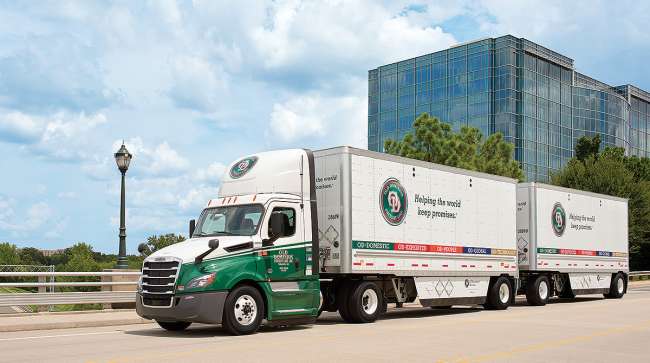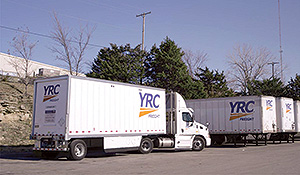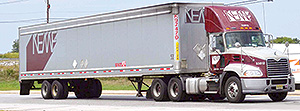LTL Carriers See Slower Growth, but Economic Outlook Remains Positive

[Stay on top of transportation news: Get TTNews in your inbox.]
Less-than-truckload carriers are settling into a more modest growth scenario as 2019 unfolds, with widely shared expectations that a still-solid U.S. economy and favorable industry fundamentals will keep fleets on a positive course.
“Overall, the underlying economy continues to be positive,” KeyBanc analyst Todd Fowler told Transport Topics. “It’s definitely taken a step down from the strength we saw at this time last year. 2018 was just phenomenal, so there are difficult comparisons to last year.”
Greg Gantt, CEO of Old Dominion Freight Line, offered a similar assessment of the market, a view shared by other LTL executives whose first-quarter results generally verified the trend toward more gradual profit increases.

The trade dispute between the United States and China could affect LTL demand, according to some analysts. (Saia Inc. via Twitter)
“Overall, the macro environment is still good. Customers are still anticipating growing their businesses,” said Gantt, whose company’s results illustrated the slower growth rate trend. Old Dominion’s first-quarter net income rose 22% year over year, after full-year 2018 earnings growth of 31% over 2017.
Veteran industry executive James Hertwig, whose career includes CEO positions at LTL fleet Carolina Freight Carriers, Landstar Logistics and two railroads, identified twin market drags.
“Lower demand growth in relation to increased capacity in the past several months is responsible for slower or flat growth,” said Hertwig, who now heads his own consulting firm.
►New management as fleets transition
►Top 100 For-Hire interactive map
►Top 100 For-Hire interactive quiz
►Female execs advancing in industry
Sector Rankings
LTL | TL/Dedicated
Intermodal/Drayage
Motor Vehicle/Driveaway
Tank/Bulk | Air/Expedited
Refrigerated | Flatbed/HS
Package/Courier | Mail
Household Goods/Commercial
The extent of the market’s softening isn’t certain.
Rick O’Dell, CEO of Saia, was one of several carriers that noted the difficulty in gauging freight demand in mid-2019 after a severe winter was followed by stronger spring volume.
Hertwig said the ongoing trade dispute between the United States and China could have a lasting effect on LTL demand.
BeyBanc’s Fowler made a related point.
The pull-forward of shipments prior to any tariffs taking effect resulted in elevated levels of inventory that continue to linger, he said. That "hangover," Fowler said, that could be a drag on freight volumes until conditions normalize.
As markets moderate, pricing is garnering attention.

Fleets such as YRC Freight said they secured solid rate increases during contract repricing. (YRC Worldwide Inc.)
Executives such as YRC Worldwide CEO Darren Hawkins and ArcBest CEO Judy McReynolds reported solid rate increases were secured during contract repricing.
Revenue per 100 pounds of freight in the most recent quarter rose for every LTL carrier that discloses results, ranging from 4% at YRC Worldwide to nearly 10% at Old Dominion.
Fowler and Satish Jindel, president of SJ Consulting Group, anticipate that sector rates will rise 3% or a bit more above 2018 levels. That pace is about half of the year-over-year increases LTL carriers as a group secured last year, Jindel noted.
“Even though this is a softer market compared to the capacity crunch we had in 2018, it appears carriers are reluctant to give back rates to get the volume back,” said Ryan Poynter, vice president of carrier relations and LTL policy for GlobalTranz. “They are content at the current volume levels and will not erode profitability to grow volume levels.”
Widespread carrier and analyst commentary described the mid-2019 pricing environment as rational. Just one carrier, Old Dominion, made any mention of aggressive pricing by competitors, and that was limited to a handful of markets.
“The industry seems to have learned lessons from some events that happened in prior downturns,” Fowler said. “The carriers are managing much more effectively,” which limits the prospects for a repeat of the 2008 and 2009 period when rate-cutting and widespread losses plagued LTL carriers.

(David B./Flickr)
A Time of Change in the LTL Sector: YRC’s Labor Deal, NEMF’s Bankruptcy
The recent bankruptcy of New England Motor Freight and YRC Worldwide’s new labor contract have refocused attention on the role of unionized carriers in the less-than-truckload sector.
YRC’s five-year pact with the International Brotherhood of Teamsters, which went into effect May 14, will benefit employees, customers and shareholders by raising wages, adding operational
flexibility and controlling costs, CEO Darren Hawkins said.
He described the deal, the first full union contract agreement in more than a decade, as “a very positive event.”
“In addition to creating a unique opportunity for YRCW to make investments in the near term, the ratified contract also positions the company to improve our profitability in 2020 and beyond by taking full advantage of the new operational tools provided for in the contract,” Hawkins said.
In contrast, New England Motor Freight, which announced its bankruptcy in February, tied its failure to “continuing and unsustainable rises in overhead as well as a severe shortage of drivers” and significant, unspecified macroeconomic factors.
Public statements by other LTL carriers that operate in NEMF’s former service area, such as Saia Inc., have reported some business volume increases and hiring of new drivers after the failure.
Workers at NEMF had been represented by the International Association of Machinists and Aerospace Workers.
Analysts cautioned against generalizations about the sector.
“You can’t treat all unionized carriers with the same brush,” Keybanc analyst Todd Fowler said. “There are no doubt some structural challenges. Some can compensate for the higher cost structure. There can be limits on price competition because of the cost structure. They have to manage more effectively.”
Said Kevin Sterling, a Seaports Global Securities analyst, “When the environment remains strong, the unionized carriers can do OK, but not necessarily thrive. They have an inherent cost-structure disadvantage that can have an impact if a pricing war breaks out.” — Rip Watson
Analysts believe that both manufacturing and retail could aid LTL fleets.
Kevin Sterling, an analyst at Seaport Global Securities, believes LTL carriers could benefit from renewed growth in North American manufacturing as trade patterns and policies change, a step that could buttress fleets’ long-term reliance on that sector.
At the same time, business in the retail sector may become more attractive for LTL carriers.
“The U.S. economy is helping LTL to the extent that they want to handle more retail customers,” Jindel said. “For a long time, those carriers were attracted to dense, heavy shipments and retail was the last to get capacity.”
Opportunities beckon for LTL as retailers are forced to move distribution centers closer to stores to shorten shipping distances and cut transit times.
LTL carriers are experiencing the same sort of transition seen in the parcel industry, where shipments traveling less than 300 miles grew three times faster over the past 15 years than cargo moving farther than that distance, he believes.
Jindel believes LTL fleets can haul retail goods profitably as long as they recognize the need to price based on lighter freight with different cube characteristics. Use of dimensioners can help with that pricing and improve operating ratios by 2 to 3 percentage points, he added.
Market shifts could create opportunities for regional fleets in a segment in which the top 10 companies control 80% of revenue.
“Regional carriers are set to thrive in 2019 and 2020,” Poynter said. “More e-commerce, shorter haul, final-mile type moves are a better fit for the regional carriers as opposed to the longhaul providers.”
National carriers also compete in time-driven markets.
“Many national carriers now mix their longhaul and regional business operations,” Hertwig said. “However, good niche regional carriers will continue to thrive based on their strength in service and density.”
As LTL evolves, there has been little sign that digital freight-matching applications are penetrating the market to the extent seen in truckload.
ArcBest’s McReynolds said customers aren’t showing much interest in these types of dispatch apps.
Fowler said one reason technology startups face difficulty penetrating the LTL market is because large freight brokers already offer a comparable service to their customers.
Fowler, Sterling and Jindel noted that the greater mix of products and destinations compared with truckload freight create greater complexity in LTL moves that present challenges for dispatch apps.
Sterling advised caution.
“These apps haven’t had an impact yet, and they might not be quite as disruptive as what we have seen in truckload,” he noted. “But we have to watch what Uber Freight does. There are a lot of smart people there.”
Jindel took a broader view, saying freight companies’ own adoption of technology can fend off new entrants.
“The only way these [dispatch app] companies are going to do anything different or more appealing is if traditional companies don’t deploy new technologies, which they have done before,” he said.
Other factors could buffet the LTL industry.
The recent bankruptcy of New England Motor Freight, which employed unionized workers, has focused greater attention on those carriers with ties to the Teamsters.
Sterling believes fuel prices could spike due to possible refining disruptions. He tied that prospect to growing demand for low-sulfur fuel for ships as a result of new International Maritime Organization rules that tighten vessel emissions standards next year.
Staffing and wages continue to be a concern, although LTL enjoys greater stability with lower turnover rates compared with truckload fleets.
“Most LTL carriers still feel a driver shortage and have implemented programs to start recruiting younger folks from the dock to drive straight trucks while they mature into a CDL driver at 21,” Poynter said. “This should help with recruitment and lower the average age of a CDL driver.”
Fowler spotlighted the cost increases arising from a shortage of maintenance technicians that could be even more severe than the lack of drivers.
Looking further into the future, the fact that 2020 will be an election year may reduce the level of uncertainty in the business environment as the focus turns to politics, Fowler said.




